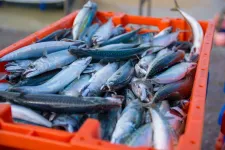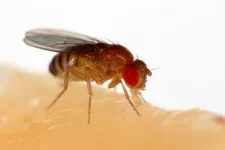(Press-News.org) Genetic rewiring could have driven an evolutionary explosion in the shapes, sizes and adaptations of cichlid fish, in East Africa's answer to Darwin's Galapagos finches.
Published in BMC Genome Biology, an Earlham Institute (EI) study, with collaborators at the University of East Anglia (UEA) and Wisconsin Institute for Discovery, shows that 'genetic rewiring' at non-coding regions - rather than mutations to protein-coding regions of genes - may play an important role in how cichlid fish are able to rapidly adapt to fill a staggeringly wide range of environmental niches in the East African Rift lakes.
The results could help future studies to improve breeding of economically important cichlid species such as tilapia - a staple in aquaculture.
Darwin's famous finches are one of the most well-known examples of evolution by natural selection, and specifically adaptive radiation. The birds he observed on the Galapagos archipelago had differences in their beaks that could be matched to fit their specific feeding habits - whether they ate big or small seeds, insects, or even used tools to find food.
Amazingly, in the 2-3 million years it took 14 species of finch to evolve on the Galapagos Islands, around 1,000 species of cichlid evolved in Lake Malawi alone.
"In the Great Lakes of East Africa, and within the last few million years, a few ancestral lineages of cichlid fish have independently radiated and given rise to well over 2,000 species - and we're still finding new ones," says first author Dr Tarang Mehta, a postdoctoral scientist in EI's Haerty Group.
"They occupy a really large diversity of freshwater ecological niches in lakes, rivers and even swamps: this includes sandy substrates, mud, rocks, and vegetated bottoms. As a result, they are all adapted to different dietary habits and niches in these areas."
By looking at gene expression across different cichlid tissues in five representative species from East African rivers and the Great Rift Lakes, the team discovered an evolutionary rewiring of several important genes linked to the adaptability seen in cichlids. The effect which was particularly prominent in the vision of fish species.
"We found out that the most rewired genes are associated with the visual system," explains Dr Mehta. "Essentially, if you look at the different species of fish we used in the study, you could see major differences in the regulation network around opsin genes they use for vision depending on where they live and what they eat.
"For example, the Lake Malawi rock-dwelling species, M. zebra, feeds on UV-absorbing phytoplankton algae. That generally requires increased expression of a particular opsin, SWS1, which helps with sensitivity to UV light. That may well explain why it has a more complex regulatory network around SWS1 compared with the Lake Tanganyika benthivore, N. brichardi, which does not share the same diet or habitat."
Armed with some genes of interest, the team confirmed the mechanisms behind these gene regulatory differences in the lab. Looking at the fine scale, they identified small changes in the DNA sequence of regulatory regions at the start of genes important for trait differences between species, including the visual system.
Rather than the gene itself being modified, it was the regions of DNA known as binding sites that are targeted by transcription factors - the proteins which determine whether a gene is turned on or turned off. In this way, the different species of fish can be said to have had their visual system 'rewired' for different functions.
Taking this further, the team was able to show that these changes could be commonly associated throughout cichlid fish in Lake Malawi, with diet and ecology-dependent rewiring showing that changes in transcription factor binding could be key to fine-tuning visual sensitivity.
Depending on the trait, cichlids appear to utilise an array of genetic mechanisms to generate phenotypic novelty however, the 'tinkering' of regulatory systems appears more widespread in cichlid fish than previously discovered. This evolutionary plasticity could well explain the explosion of species in such a small area over a relatively short time.
"It's a proof of concept," says Dr Mehta. "As more data comes out, we'll be able to look at this in depth in representative clades from each of the different radiations, not just in Lake Malawi but also Lake Tanganyika, Lake Victoria and even in some of the cichlids in South America."
Professor Federica Di Palma, Professorial Fellow of Biodiversity at UEA, said: "We have released an impressive amount of expression data which will further aid studies into the adaptive radiation of cichlids for the future. We are now deciphering the complexity of these cis-regulatory regions by using genome-wide CRISPR screens.
"The wider impact of our regulatory gene network approach will also help inform evolution of agriculturally important traits for tilapia such as growth rate and tolerance to different local water conditions, as well as for general aquaculture and fisheries."
INFORMATION:
You can access the paper, here: https://genomebiology.biomedcentral.com/articles/10.1186/s13059-020-02208-8
ATLANTA - JANUARY 19, 2021 - A new study finds that alcohol consumption accounts for a considerable portion of cancer incidence and mortality in all 50 states and the District of Columbia. The article, which appears in Cancer Epidemiology, states that the proportion of cancer cases attributable to alcohol consumption ranged from a high of 6.7% in Delaware to a low of 2.9% in Utah. Similarly, Delaware had the highest proportion of alcohol-related cancer deaths (4.5%) and Utah had the lowest (1.9%).
This study conducted by Farhad Islami, MD, PhD, and colleagues at the American Cancer Society is the first to estimate contemporary proportions and counts of alcohol-attributable ...
Psoriasis is a chronic inflammatory skin disease characterized by erythematous (red) patches and plaques. In some patients, psoriasis may be associated with comorbidities such as arthritis, obesity, diabetes, cardiovascular diseases, hyperlipidemia, or depression. Psoriasis lesions can occur on the scalp and face, in addition to all other areas of the body, causing considerable physical discomfort and psychosocial trauma from the stigma surrounding appearance defects.
More than 90% of patients with psoriasis have what is called psoriasis vulgaris, which is characterized ...
Researchers in the UK and the United States have succeeded in 'fine tuning' a new thermoplastic biomaterial to enable both the rate at which it degrades in the body and its mechanical properties to be controlled independently.
The material, a type of polyester, has been designed for use in soft tissue repair or flexible bioelectronics by a team at the University of Birmingham in the UK and Duke University in the US.
Materials that successfully replicate the necessary elasticity and strength of biological tissues but which also biodegrade over an appropriate timescale are extremely ...
DANVILLE, Pa. - A team of Geisinger researchers has identified a common genetic variant as a risk factor for stroke, especially in patients older than 65.
Cerebral small vessel disease (SVD) causes about a quarter of ischemic strokes worldwide and is the most common cause of vascular dementia. SVD can manifest as lesions on the brain, which typically appear on brain scan images. SVD is commonly associated with aging and hypertension, but a minority of cases are caused by cysteine altering variants in the NOTCH3 gene. Approximately 1 in 300 people have this type of gene variant. A rare hereditary condition known as cerebral autosomal dominant arteriopathy with subcortical infarcts and leukoencephalopathy, or CADASIL, which is caused by this gene variant, has been associated with ...
Fear of losing your job, worrying about you or a loved one getting sick, and online meetups with family and friends you have not seen for months. The COVID-19 lockdown has completely changed everyday life for most people around the world. Physical distancing is the new normal and an extremely important tool in the fight against the pandemic.
However, the effects of the lockdown on mental health are alarming - especially for young people under 30 and people with preexisting mental health issues. This is the conclusion of a new study from the University ...
Consumers of purchased foods have no way of ascertaining the quality and safety of the food that existing distribution systems deliver to their plates. Unfortunately, inappropriate refrigeration can sometimes lead to food spoilage, which is often difficult to detect. Such is the case for mackerel fish, which readily develop harmful levels of a substance called histamine when left at room temperature for too long. Histamine is neurotoxic and can trigger severe allergic reactions, including rashes, vomiting, and diarrhea. Because spoiled fish can sometimes look and smell completely normal, it is important to accurately quantify ...
Scientists are searching for lithium technology alternatives in the face of the surging demand for lithium-ion batteries and limited lithium reserves. Russian researchers from Skoltech, D. Mendeleev University, and the Institute of Problems of Chemical Physics of RAS have synthesized and tested new polymer-based cathode materials for lithium dual-ion batteries. The tests showed that the new cathodes withstand up to 25,000 operating cycles and charge in a matter of seconds, thus outperforming lithium-ion batteries. The cathodes can also be used to produce less expensive potassium ...
Having a choice of foods may accelerate aging and shorten the lifespan of fruit flies, according to a study published today in the open-access eLife journal.
While early experiments have shown that calorie restriction can extend lifespan, the current study adds to the growing body of evidence that suggests other diet characteristics besides calories may also influence aging and lead to earlier death.
"It has been recognised for nearly a century that diet modulates aging," says first author Yang Lyu, Postdoctoral Fellow at the Department of Molecular & Integrative Physiology, University of Michigan Medical School, Ann Arbor, US. "For our study, we wanted to see if having a choice of foods affects metabolism and lifespan in the fruit fly Drosophila melanogaster."
Lyu ...
LEBANON, NH - A joint team of researchers from Radiation Oncology at Dartmouth's and Dartmouth-Hitchcock's Norris Cotton Cancer Center (NCCC), Dartmouth Engineering, and Dartmouth-Hitchcock's Department of Surgery have developed a method to convert a standard linear accelerator (LINAC), used for delivery of radiation therapy cancer treatment, to a FLASH ultra-high-dose rate radiation therapy beam. The work, entitled "Electron FLASH Delivery at Treatment Room Isocenter for Efficient Reversible Conversion of a Clinical LINAC," is newly published online in the International Journal of Radiation Oncology, Biology & Physics.
The exceptionally high dose rate is 3,000 times higher than normal therapy treatment (300 Gray per second vs. 0.1 Gray per second, Gray being a standard ...
Skoltech scientists and their colleagues from the Russian Quantum Center revealed a significant role of nuclear quantum effects in the polarization of alcohol in an external electric field. Their research findings are published in The Journal of Physical Chemistry.
Molecular liquids, such as water or alcohols, are known to be polar. Polarity results from the charge separation mechanism, the microscopic description of which still bears some open questions. In fact, the basic description of the polarization rests on a hundred-years-old concept: the dielectric polarization is connected to the molecular dipole moment due to their hydroxyl ...




